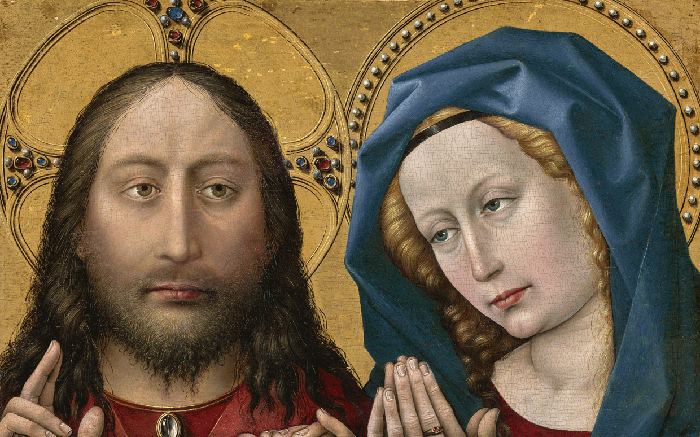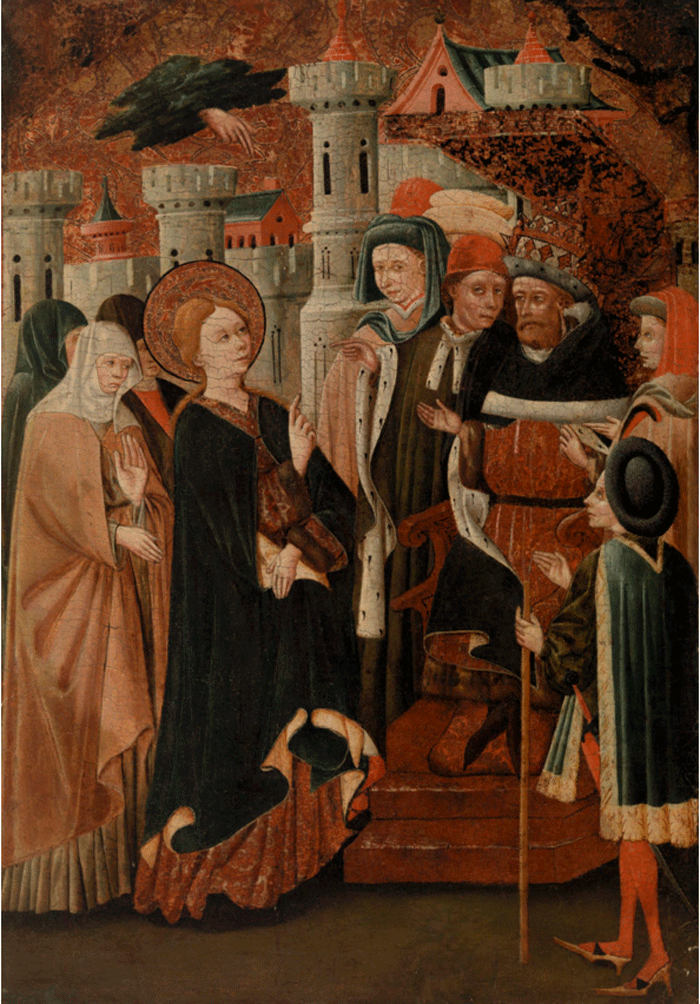Christ and the Virgin, c. 1430‑1435. Robert Campin, also called the Master of Flémalle, Netherlandish (active Tournai). Oil and gold on panel, 11 1/4 x 17 15/16 inches. Philadelphia Museum of Art, John G. Johnson Collection, 1917.
A Guided Tour of Philadelphia in the Year 1430
by DoN Brewer
Of course, Philadelphia didn’t exist in 1430, but there are artifacts, artworks, and traditions from the distant past, a pivotal moment in history, that are right here and now with us in the future like the Tardis in a Dr. Who episode. The time traveling art tour will make multi-dimensional stops at three artworks from the early 15th century that you can experience on the Benjamin Franklin Parkway in Philadelphia, PA, USA, Planet Earth. I’ll make recommendations on how to contrast and compare traditions of contemporary life that actually originated in the Late Middle Ages in Burgundy with Philly’s regional influence on art and culture. Examining the change in traditions reveals parallels between then and now in not just art, but everyday aspects of life like fashion, food, and decor. There once was a country called Burgundy that spanned eastern France where art was integral to communications, influence, status and lifestyle, during the rule of the Duke of Burgundy, Philip the Good, and Jan van Eyck, the great painter, was his best friend and confidant.
This guide is being written primarily as my final project for The Traditions of Art at the Barnes Foundation in pursuit of a certificate in art and esthetics, and as a way to share with you what I’ve been learning about painting and art traditions. I will offer analytic context to art in Philadelphia at the PMA and the Barnes, and the Burgundian influence on contemporary life in reviews on DoNArTNeWs via a series of blog posts. In the blog posts I will be examining the plastic qualities of three paintings, their subject facts, and their connections to us, to each other, and traditions of art through space and time. William Perthes, senior instructor at the Barnes, encouraged me to do something different than write an essay. My goal is to connect you to the art and traditions of 1430 Burgundy, at the apex of the Late Middle Ages on the cusp of the Renaissance, with the extraordinary influences on art and popular culture in the 21st Century.
Our time capsule tour of Philadelphia begins at The Philadelphia Museum of Art, the Old Masters Now selections from the Johnson Collection, with a painting by Robert Campin depicting Christ and the Virgin, c. 1430‑1435. A horizontal composition dominated by dual portraits with amazing spatial illusion and design, this painting had a spectacular impact on the arts from that time forward, no joke. The traditions of painting made a major change of direction at this moment with the development of the use of oil paints. Before this temporal distortion, tempera paint, a mixture of ground pigment in egg yolk, was used by artists following long established norms and customs, creating paintings following influential traditions. The shift towards oils from tempera, in contemporary terms, is like the game-changing code upgrade from Nintendo 64, a 2D gaming platform for TV, to Sony Playstation VR, virtual reality.
Link to Robert Campin art tour blog post – click here.
Saint Francis of Assisi Receiving the Stigmata, 1430‑1432. Jan van Eyck, Netherlandish (active Bruges). Oil on vellum on panel, 5 x 5 3/4 inches. Philadelphia Museum of Art, John G. Johnson Collection, 1917.
We will visit a major tempera artwork on the tour later on. The next stop in 1430 is a few steps away in the gallery at the art museum, Jan van Eyck’s Saint Francis of Assisi Receiving the Stigmata,1430‑1432, a small, intricate artwork revealing aspects of painting developed at a peak of invention and change in the arts. The story of Jan Van Eyck traveling to Portugal to help broker the marriage deal between Queen Isabella and Peter the Good is directly connected to the Robert Campin painting in a fabulously adventurous diplomatic trip made by the artist in the late 1420s. Plastic analysis of the artwork, as far as composition, line, light, shape, and color of the art objects themselves is the major theme to this guide but also I’m excited about offering context to the business of art-making naturally built into the story.
Why did Jan Van Eyck paint this tiny picture? Why is it so detailed? How did he do it? Let’s just say that the young artist hacked the Master of Flémalle like a coder from a Russian bot farm, downloaded all the data from the great teacher’s information base, took the information back to the royal court in Burgundy to dazzle the Duke and, for a long, long time, became known as the inventor of oil painting. The tiny painting is so packed with data about art, technology, humanism, traditions, and culture that each paint stroke is like a hyper-link.
Link to Jan van Eyck art tour blog post – click here.
Blasco de Grañén, Saint Catherine of Siena before Pope Gregory XI, 1422–1459. Tempera with gold leaf on panel, Overall: 34 x 23 1/2 inches, The Barnes Foundation.
An examination of Blasco de Grañén‘s, Saint Catherine of Siena before Pope Gregory XI at The Barnes Foundation will help you recognize the sea change in art and culture that took place in the Late Middle Ages that continues today in the Philadelphia arts community through the traditions of our art schools, studios, and universities. The art tour blog posts will look at the plastic qualities of the surface of the paintings, color, light, and shapes. To differentiate traditions in artwork before the discovery and wide acceptance of single point perspective in the art of drawing and painting, a system of describing three dimensional space on a 2D surface, intersects the time-line. In a worm hole, time-trippy, way, this painting encapsulates the history of art from flat, obvious, drawing towards realistic draftsmanship and the pursuit of visual naturalism, spatial illusion, illustrative descriptive line, and a vanishing point in paintings. Over time there has been a shift back to the subject of painting being about the surface, color and light and less about representational illustrativeness in genre paintings.
Link to Blasco de Grañén art tour blog post – click here.
Finally, I will be offering recommendations for how you can experience aspects of Burgundian life, party like it’s 1430, through art, architecture, fashion, weaving and fabrics, foods, and music in Philadelphia. This is a time travel adventure to the moment when the convergence of the knowledge of optics, discovery of better art materials, honed virtuoso artistic skill, and a driven vision towards a new reality are realized with incredible temporal effect, like a star trek through arts and culture without leaving Philadelphia.
Jan van Eyck would have felt at home in Philly, traditions of modern life that we take for granted were refined in the courts of Burgundy; the artist would find fine art collections, exquisite fabrics, an embedded arts community, talented craftspeople, intellectuals, and a comfortable lifestyle brimming with culture and traditions right in Center City. Now instead of weaving thread into textiles in the great wool mills of Tournai, Belgium, where artist Robert Campin had his studio and school, the artisans and knowledge engineers of today are creating code to power smart phone apps on North Third St, in the Old City arts district of Philadelphia, N3RD Street.
Philip the Good, the Duke of Burgundy reigned during the most prosperous, creative, and industrious time in the history of the country. The creative arts were already well established in Burgundy, a magnet to artists from all over the region, vibrant international commerce and trade, and advanced technologies. Weaving and fine fabrics play an integral role to this tour, literally the thread of the narrative, painting fabrics in 2D is like writing code, a language unto itself. The Burgundian influence of 1430, established across one of the largest ducal territories in Europe, set the standard for modern living in the royal houses so dramatically high, and essential, that the influences can be experienced in the way we live today through the arts and technology.
Link to The Philadelphia Museum of Art, Old Masters Now, press release on DoNArTNeWs.
Link to Robert Campin art tour blog post – click here.
Link to Jan van Eyck art tour blog post – click here.
Link to Blasco de Grañén art tour blog post – click here.
Link to Party Like it’s 1430 blog post – click here
Written by DoN Brewer.
Thank you to The Barnes Foundation, William Perthes, Bill Scott, Robert Bohne, Betty Macdonald, Wikipedia, Britannica.com, Dr. Albert Barnes, Gardner’s Art Through the Ages, and The Philadelphia Museum of Art.
Like DoNArTNeWs Philadelphia Art News Blog on facebook
Follow DoN on Twitter @DoNNieBeat58
@donniebeat on Instagram
More DoNArTNeWs at www.brewermultimedia.com
Affiliate Marketing Disclosure Statement
Donate via safe and secure PayPal in the sidebar.






{ 0 comments… add one now }
You must log in to post a comment.
{ 4 trackbacks }